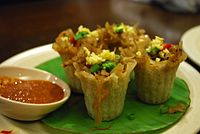Pie tee
 Pie tees served in Kuala Lumpur, Malaysia | |
| Course | Pastry |
|---|---|
| Place of origin | Malaysia[1][2][3][4] |
| Region or state | Southeast Asia |
| Associated cuisine | Malaysia, Singapore, Indonesia |
Kueh Pie Tee is a thin and crispy pastry tart shell kuih often filled with a spicy, shredded Chinese turnips, sweet mixture of thinly sliced vegetables and prawns. It is a popular Peranakan dish, that is often consumed during Chinese New Year or tea parties. The shells are made of flour and though some stores will make them from scratch, they can usually be found ready made in most supermarkets. Similar to popiah, the main filling is shredded jicama and carrots, and usually these two dishes are sold by the same stall in hawker centres.[5]
Etymology[edit]
Kueh Pie Tee is known by different names across the Southeast Asia region, with several variations in spelling. Kueh Pie Tee is pronounced /ˈkweɪ ˈpaɪ ˈtiː/, and is also known as Koay Pai Ti', 'Kuih Pie Tee' or 'Kuih Pai Ti. The word 'kueh' is a loanword that combines the Malay word kueh, which means dessert, and from the Minnan dialect kueh (Minnan: kueh or koé (粿); Chinese: 粿; pinyin: guǒ) which means a flour-based dish.[6] 'Pie' is derived from the English word 'pie' while other regional variations that use pai uses it as a loanword from the Malay language, 'pai' which means pie. In other accounts, the phrase pie tee (or pai ti or pai tee) may have been derived from the English term 'patty'.[2][7]
In Malaysia, the kueh pie tee is also known as Tophats, suggesting that part of the dish was likely influenced by Western culture.[2]
History[edit]
While the origins of the kueh pie tee remain unclear, there are several speculations on how the Kueh Pie Tee was invented. Based on currently available sources, the Kueh Pie Tee was invented in the early 20th century.[4] The kueh pie tee is believed to be derived from the popiah. The popiah was likely introduced to the Southeast Asia region by the Chinese migrants moving there. The snack's prolonged exposure to its surrounding multi-ethnic influences, such as Malay cuisine and Western cuisine, led to the adaptation of the original 'baobing' recipe to create the kueh pie tee.
In Malaysia, many locals recognise the kueh pie tee by the name 'Tophats' instead because the piecrust shell resembles Western tophats. As such, some locals in Malaysia believe that the kueh pie tee may have been invented in Malaysia.[2][7]
Another possible speculation suggests that the kueh pie tee is originally from Singapore. One of the earliest recorded kueh pie tee recipes is found in Ellice Handy's My Favourite Recipes, published in 1952. This recipe book was one of the first few recipe books that featured Malayan dishes and ingredients. In this recipe book, the instructions to make the kueh pie tee are found in two recipes named the Popia and the Pie Tee. Handy's Popia recipe provides steps to make the kueh pie tee's filling, while her Pie Tee recipe contains instructions to make the piecrust shells.[8] Noting that the recipe is found in a recipe book published in Singapore, this suggests that the kueh pie tee's origins may be related to the local cuisine of Singapore.
Baba Ong Jin Teong has also suggested in his Peranakan heritage books that the Kueh Pie Tee may have originated in Singapore. The recipe found in Ong's book, Penang Heritage Food, belongs to his mother, who compiled the recipe in the 1950s. Additionally, the kueh pie tee is also known as the 'Singapore Poh Piah' or 'Syonan-to Pie', further suggesting that the snack may have originated from Singapore.[4]
Currently, the kueh pie tee remains popular in Singapore, Malaysia and Indonesia.
See also[edit]
References[edit]
- ^ "Pie tee - Traditional Savory Pastry From Malaysia". TasteAtlas. 2018-08-31. Retrieved 2023-02-24.
- ^ a b c d "This Top Hat-Shaped Pastry Gets Filled With Vegetables and Spices". Atlas Obscura. Retrieved 2023-02-24.
- ^ "Kueh Pie Tee". May 22, 2016. Archived from the original on October 14, 2020. Retrieved October 11, 2020.
- ^ a b c Ong, Jin Teong (2015). Penang Heritage Food. Singapore: Landmark Books. p. 85. ISBN 9789814189613.
- ^ Phaik, Lim Kwee (2002). Nyonya flavours. Sydney: L.K. Phaik. ISBN 0-9577848-2-1. OCLC 223802505.
- ^ 周长楫. (2002). Xinjiapo Min nan hua ci dian. Changji Zhou, Qinghai Zhou, 周长楫., 周清海 (Di 1 ed.). Beijing: Zhongguo she hui ke xue chu ban she. p. 96. ISBN 7-5004-3530-4. OCLC 52334441.
- ^ a b Tan, Chee-Beng, ed. (2011). Chinese food and foodways in Southeast Asia and beyond. Singapore: NUS Press. p. 35. ISBN 978-9971-69-603-0. OCLC 794700730.
- ^ Handy, Ellice (2012). My favourite recipes (Further rev. ed.). Singapore: Landmark Books. p. 57-58. ISBN 978-981-4189-39-2. OCLC 825542838.

